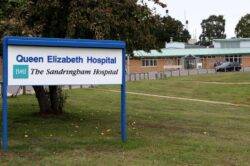General view of The Queen Elizabeth Hospital in Kings Lynn, Norfolk which close to Anmer, and Anmer Hall, on the Royal Sandringham Estate in Norfolk (Picture: PA)
Seven hospitals have been deemed unsafe after being made with what’s been dubbed as ‘Aero bar’ concrete.
The buildings were constructed using reinforced autoclaved aerated concrete (RAAC) which could suddenly collapse, the government has said.
It comes as schools were ordered to fully or partially close by the Department for Education (DfE), due to the same issue.
A total of 104 schools in England have been affected so far.
The lightweight material was used in public buildings from the 1950s up to the mid-1990s, but is now seen as unsafe.
Earlier this year, NHS Providers published a report calling for the ‘long-neglected’ NHS estate in England to be brought ‘into the 21st century’.
It also described RAAC as presenting a ‘major and unjustifiable safety risk’.
A general view of Frimley Park Hospital in Frimley, Surrey (Picture: PA)
General view of West Suffolk Hospital in Bury St Edmunds (Picture: PA)
The James Paget University Hospital in Gorleston, Norfolk (Picture: PA)
The government said it ‘remains committed’ to eradicating RAAC from the NHS estate by 2035 and rebuilding the seven most affected hospitals by 2030.
Sir Julian Hartley, chief executive of NHS Providers, said the organisation ‘welcomed’ recent government action, but called for all trusts to have access to cash to replace RAAC where necessary.
‘We welcomed recent government action to replace dangerous, crumbling old concrete blocks in ceilings and walls by ensuring the seven trusts with the most critical RAAC risk will be replaced by 2030,’ he added.
‘The government has made a commitment that the remaining RAAC risk will be removed from the NHS estate by 2035.
‘However, it is vital that all trusts can access the necessary capital funding to replace these concrete planks as soon as possible.’
What is RAAC?
Reinforced autoclaved aerated concrete (RAAC) is a lightweight building material used from the 1950s up to the mid-1990s, but now assessed to be at risk of collapse.
It’s a ‘bubbly’ form of concrete usually found in roofs and occasionally in walls and floors and has been compared to Aero chocolate bars.
It looks like normal concrete, but it’s weaker and less durable. RAAC was favoured in construction projects because of its lightweight thermal properties.
Experts say the building material is less durable than reinforced concrete and deteriorates over time, so is susceptible to sudden failure.
It has a life expectancy of little more than 30 years and this means buildings constructed from the 1950s to the 1990s that have not been checked by structural engineers are at risk of collapse.
RAAC is also prone to collapse when wet – which can happen if a building’s roof leaks.
When asked by the BBC if hospitals are safe, schools minister Nick Gibb said: ‘Yes, they are. Hospitals are very large buildings. They have big and expert maintenance teams in those hospitals.
‘They can use propping, and they are using propping so they can move patients from one ward to the other.
‘It’s a very different estate from the school estate.’
RAAC concrete is believed to be in 34 hospitals in England but only the seven have been prioritised for urgent rebuilding.
An investigation by the Liberal Democrats previously found evidence of chemical leaks in patient areas at a number of hospitals in England, as well as broken fire alarms in some facilities.
The government launched its New Hospitals Programme in 2020 pledging to build 40 new hospitals by 2030.
But the National Audit Office (NAO), a public spending watchdog, has said it is not currently on track to meet this target.
The seven hospitals deemed at risk due to RAAC are:
Airedale in West Yorkshire
Queen Elizabeth King’s Lynn in Norfolk
Hitchingbrooke in Cambridgeshire
Mid Cheshire Leighton in Cheshire
Frimley Park in Surrey
West Suffolk Hospital in Bury St Edmunds
James Paget Hospital in Norfolk
Get in touch with our news team by emailing us at [email protected].
For more stories like this, check our news page.
It comes as several schools were ordered to fully or partially close due to the same problem.





